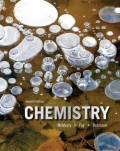
Concept explainers
To determine:To find the non-metallic character of
Concept introduction:
According to electron acceptance of the element electronegative character will be defined. When an anion is form then it is said to be non-metallic or electronegative in nature. For ex: chlorine, phosphorus, oxygen. These will show greater electronegativity or non-metallic characters than cations.
Answer to Problem 22.1P
Solution: Bromine has more non-metallic character in the pair
Explanation of Solution
Bromine and germanium both belongs to the same row in the periodic table. But bromine is placed on the right side of the table and germanium is placed on the left side of the table. Hence it is evident that bromine is more non-metallic than germanium.
c)
To determine:To find the non-metallic character of
Concept introduction:
According to electron acceptance of the element electronegative character will be defined. When an anion is form then it is said to be non-metallic or electronegative in nature. For ex: chlorine, phosphorus, oxygen. These will show greater electronegativity or non-metallic characters than cations.
Answer to Problem 22.1P
Solution: Selenium has more non-metallic character in the pair
Explanation of Solution
Indium belongs to 3A and selenium belongs to 6A groups. The metallic character decreases as we go from left to right, thus, selenium is found to be more metallic as it is placed below the indium in the periodic table.
d)
To determine:To find the non-metallic character of
Concept introduction:
According to electron acceptance of the element electronegative character will be defined. When an anion is form then it is said to be non-metallic or electronegative in nature. For ex: chlorine, phosphorus, oxygen. These will show greater electronegativity or non-metallic characters than cations.
Answer to Problem 22.1P
Solution: Chlorine has more non-metallic characters in the pair
Explanation of Solution
The chlorine has more non- metallic character than tellurium because chlorine lies above the tellurium in periodic table and also it is place right to tellurium.
Want to see more full solutions like this?
Chapter 22 Solutions
EBK CHEMISTRY
 ChemistryChemistryISBN:9781305957404Author:Steven S. Zumdahl, Susan A. Zumdahl, Donald J. DeCostePublisher:Cengage Learning
ChemistryChemistryISBN:9781305957404Author:Steven S. Zumdahl, Susan A. Zumdahl, Donald J. DeCostePublisher:Cengage Learning ChemistryChemistryISBN:9781259911156Author:Raymond Chang Dr., Jason Overby ProfessorPublisher:McGraw-Hill Education
ChemistryChemistryISBN:9781259911156Author:Raymond Chang Dr., Jason Overby ProfessorPublisher:McGraw-Hill Education Principles of Instrumental AnalysisChemistryISBN:9781305577213Author:Douglas A. Skoog, F. James Holler, Stanley R. CrouchPublisher:Cengage Learning
Principles of Instrumental AnalysisChemistryISBN:9781305577213Author:Douglas A. Skoog, F. James Holler, Stanley R. CrouchPublisher:Cengage Learning Organic ChemistryChemistryISBN:9780078021558Author:Janice Gorzynski Smith Dr.Publisher:McGraw-Hill Education
Organic ChemistryChemistryISBN:9780078021558Author:Janice Gorzynski Smith Dr.Publisher:McGraw-Hill Education Chemistry: Principles and ReactionsChemistryISBN:9781305079373Author:William L. Masterton, Cecile N. HurleyPublisher:Cengage Learning
Chemistry: Principles and ReactionsChemistryISBN:9781305079373Author:William L. Masterton, Cecile N. HurleyPublisher:Cengage Learning Elementary Principles of Chemical Processes, Bind...ChemistryISBN:9781118431221Author:Richard M. Felder, Ronald W. Rousseau, Lisa G. BullardPublisher:WILEY
Elementary Principles of Chemical Processes, Bind...ChemistryISBN:9781118431221Author:Richard M. Felder, Ronald W. Rousseau, Lisa G. BullardPublisher:WILEY





